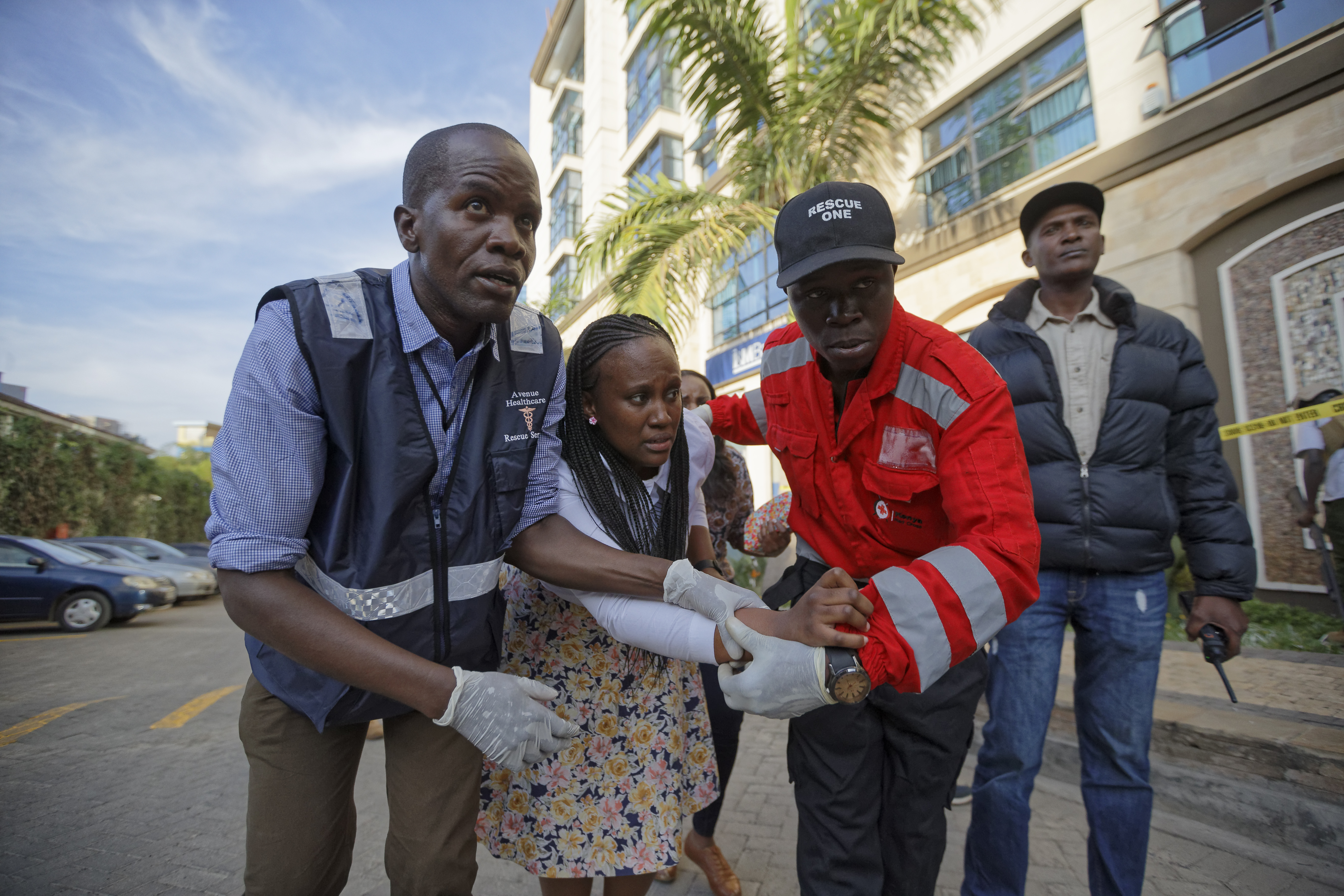
A civilian is helped by paramedics at a hotel complex in Nairobi, Kenya, where terrorists attacked an upscale hotel and office complex in January 2019, killing 21 people
On January 15, 2019, five armed men attacked a luxury hotel and office complex in Nairobi, Kenya, blasting their way through with grenades and firing indiscriminately. By the time the siege was over about 20 hours later, at least 21 people were dead; terror group Al-Shabaab claimed responsibility.
Kenya is no stranger to terror attacks. In August 1998, the U.S. Embassy—at the time located at a busy intersection in the heart of downtown Nairobi—was bombed, leaving 213 dead. The attacks escalated after 2011, when the Kenyan military entered Somalia to pursue the militants. In recent years, the deadliest attack was in April 2015 when 147 people, most of them students, were massacred at Garissa University College.
But the attack on the DusitD2 complex at the beginning of this year unfolded in a significantly different way. As expected, within minutes of the attack, international news organizations had already published the story online. However, the decision by a number of outlets to publish a photo of two obviously dead men slumped over the tables where they were having lunch—the attack wasn’t even over by the time the photo was published—was instantly condemned by Kenyans on social media.
The New York Times attracted the greatest criticism over the photograph, although other outlets including the U.K.’s MailOnline and Germany’s Bild had also published the pictures. Kenyans online—Twitter, in particular—demanded that The New York Times take down the photo and issue an apology as it was insensitive to the families of the victims, some of whom hadn’t even been notified by the time the story was being published. The way the Times reporter on the ground dismissed the complaints even though she didn’t personally choose the photos made Kenyans on Twitter even angrier. In tweets that were later deleted, she said, “Please direct your concerns to the [NYT] photo desk, thank you.”
The Times itself issued three responses as criticism raged on, first in a tweet saying that the Times understood the concern but it was “important to give our readers a clear picture of the horror of an attack like this.” Two days later, Phil Corbett, the Times’s associate managing editor for standards, defended the decision to publish the photo and reiterated that it was in line with editorial policy. Additionally, Meaghan Looram, the paper’s director of photography, and Marc Lacey, national editor and former foreign correspondent, in a published Q&A conversation, still defended the decision to publish, but added that it was a difficult decision that was not taken lightly, and that editorial standards are considered on a case-by-case basis.
The question of who gets to have dignity in death, and whose death is a mere spectacle to feed the news cycle, is a highly emotive one. Jessica M. Fishman’s 2017 book “Death Makes the News” extensively explored this dynamic, examining three decades of photojournalism in about six major American newspapers. She concluded that whereas the magnitude of tragedy in a “foreign” (relative to the U.S.) country has a direct relationship to the probability of its graphic images being published in U.S. newspapers, the inverse is true for tragedies on American soil. “When news cameras document foreign tragedy, it is argued that these kinds of ‘unsettling’ images should be shown precisely because they harness the horror, but pictures documenting American bodies are actually condemned for being disturbing.”
Fishman’s research showed that U.S. media often publish pictures of resilience and strength—such as images of the American flag, or celebrating the bravery of first responders—in the wake of domestic disasters, a stark contrast to the photos of corpses they frequently publish after similar tragedies overseas.
The exception, on American soil, is tragedies that are inflicted on Black Americans. News coverage of Hurricane Katrina in 2005 bears witness to this. In the summer of 2014, the body of Michael Brown lay for hours on the ground in Ferguson, Missouri, and appeared on the front page of the Times. Graphic photos and videos of other dead or dying Black Americans—Philando Castile, Alton Sterling, Tamir Rice, Eric Garner, Stephon Clark—have been published and circulated in major news outlets.
This double standard is a long running one that continues to be sensitive for both “foreign” correspondents—who mostly believe they are doing their journalistic duty—and the communities they cover, who often feel exploited and objectified.
However, as the Nairobi-NYT debacle showed, in the context of a globalized world, this double standard cannot remain hidden for much longer. Thanks to technology, people in those “foreign lands” are present in the global sphere, consuming news just like American audiences, speaking up for themselves, and expecting to be listened to and taken seriously.
It is interesting that in their defense, the Times said it was dedicated to giving “our readers” a clear sense of the horror of such an attack. That statement implies that the Times did not consider Kenyans to be in the category of their readers; yet going by the outcry on social media, Kenyans actually read their story, only for their concerns to be initially dismissed and then rationalized in the service of a separate abstract audience that “needed” to see the photos. Who in “the world” was actually demanding the photo in its graphic rendering?
When they disregard the people they claim to be speaking for, then international news organizations might actually be in a kind of inadvertent collaboration with groups like Al-Shabaab. In the words of Kenyan filmmaker Jim Chuchu, they act hand in hand, “one to create the senseless horror, and the other to depict it graphically, truthfully for the world to see. A structural pairing that claims to avow the other, but are actually a macabre dancing pair… one armed with a gun and a cast-iron ideology, the other with a righteous camera and a cast-iron editorial policy.”
In a highly interconnected world, “foreign lands” can no longer be thought of as “out there,” as passive unknowns whose joys and anguishes are just waiting to be discovered by an intrepid reporter. Reporters, particularly those who consider themselves foreign correspondents, can no longer assume that they are the “voice of the voiceless.” That paradigm has to end; the people in so-called foreign lands actually have voices, and it is time we respected them, just as we would respect audiences closer to home.


